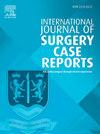“Complication unveiled: Bilateral pulmonary embolism in the wake of shoulder arthroplasty” a case report
IF 0.6
Q4 SURGERY
引用次数: 0
Abstract
Introduction and importance
Most common cases of Venous thromboembolism (VTE) seen for those who underwent for lower limb reconstruction and orthopedic trauma surgery in general. VTE was a rare surgical complication after shoulder replacement surgery. This study highlights that pulmonary embolism following upper extremity surgery increased in prevalence without currently guidelines for thromboembolism prevention during upper extremity surgeries especially shoulder arthroplasty surgeries.
Case presentation
80-year-old female patient presented at clinic with right shoulder pain. Clinical features and radiological investigations were suggestive of rotator cuff arthropathy. Following the diagnosis, the patient underwent right shoulder reverse arthroplasty. Two days post operation, the patient exhibited confusion and a decline in consciousness level also decrease in oxygen saturation levels. Clinical features and investigations pointed towards acute pulmonary embolism as the cause of the symptoms. Prompt intervention was initiated, and the patient was started on anticoagulant therapy to manage the condition. With appropriate management, the patient stabilized and was discharged from the hospital.
Clinical discussion
Diagnosis of PE need detailed history and physical examination including vital signs and modality of imaging like spiral Computed Tomography scan, risk factors for pulmonary embolism in patients who underwent shoulder arthroplasty were old age, prolonged surgery, female gender, obesity, diabetes, fluid and electrolyte imbalances, prolonged surgery and undergoing shoulder arthroplasty.
Conclusion
prophylactic anticoagulant therapy should be considered in patients with Risk factor for pulmonary embolism. There is a need to implement strategies, relevant guidelines, and policies to manage high-risk cases with a suspicion of thromboembolism post-shoulder arthroplasty.
求助全文
约1分钟内获得全文
求助全文
来源期刊
CiteScore
1.10
自引率
0.00%
发文量
1116
审稿时长
46 days

 求助内容:
求助内容: 应助结果提醒方式:
应助结果提醒方式:


